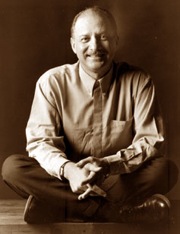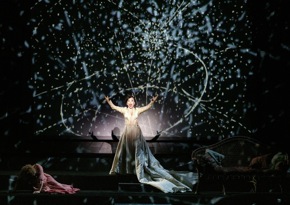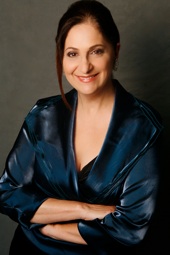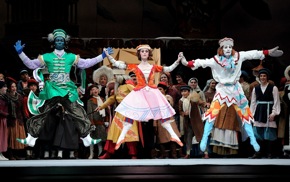Cabrillo: New Music Nirvana
Let's play Jeopardy. Answer: "Who will win the A.S.C.A.P. Award for Adventurous Programming of Contemporary Music in 2011?" Question: "What is the Cabrillo Festival of Contemporary Music?"
That's only a $200 question, because it happened 27 consecutive times before, but, looking at the upcoming season — the festival's 49th and Music Director Marin Alsop's 20th — you can pretty much take that to the bank.
The Santa Cruz event, running from July 31 through Aug. 14, will feature seven world premieres: works by Mark Adamo, John Corigliano, Michael Daugherty, and Avner Dorman, plus one by Philip Glass, dedicated to Alsop on her anniversary.
Also planned: two U.S. and nine West Coast premieres, with 15 composers in residence. Besides Daugherty, they are Mason Bates, Margaret Brouwer, Chiayu, Anna Clyne, Tina Davidson, Robin de Raaff, Zosha Di Castri, Pierre Jalbert, Elena Kats-Chernin, Shuko Mizuno, Behzad Ranjbaran, Christopher Rouse, George Tsontakis, and Dan Welcher.
Guest artists include pianist Jean-Yves Thibaudet, horn player Kristin Jurkscheit, and electric guitarist D.J. Sparr. National Public Radio host Scott Simon joins the festival for an interview program with Alsop, "In the Blue Room."

Alsop has long championed the work of James MacMillan, and the West Coast premiere of his Piano Concerto No. 3 ("Mysteries of Light") marks the ninth work the Scottish composer has presented at Cabrillo.
Mason Bates, who currently serves as composer in residence with the Chicago Symphony, will have the West Coast premiere of his Desert Transport, a work about flying over the Arizona landscape in a helicopter.
Pulitzer- and Grammy-winning Christopher Rouse's Odna Zhizn (A life) will be the 18th of his works that Alsop presents at the festival; it’s an "homage to a person of Russian ancestry who is very dear to me," says Rouse.
In a dazzling international lineup, Cabrillo features such composers as Soviet-born Australian Elena Kats-Chernin, Iranian Behzad Ranjbaran, Japanese Shuko Mizuno, Canadian Zosha Di Castri, Dutch Robin de Raaff, Taiwanese Chiayu, and others.
Check the festival Web site for complete season information.
Daniel Catán Dies
Composer Daniel Catán died suddenly Saturday in Texas. He was 62 and in good health, and died in his sleep without suffering from a known illness.
Born in Mexico City, of Sephardic-Jewish and Russian descent, Catán was the first Mexican composer to have an opera produced in the U.S., when San Diego Opera premiered his Rappaccini's Daughter in 1994.
He received a Ph.D. from Princeton University, where he studied with Milton Babbitt, James K. Randall, and Benjamin Boretz.
His latest opera, Il postino, with Plácido Domingo in the role of Pablo Neruda, premiered at the Los Angeles Opera last fall.
At the time of his death, he was working on an operatic adaptation of the Frank Capra movie Meet John Doe, which was to be performed at University of Texas, Austin, next year.
San Francisco Opera General Director David Gockley co-commissioned Catán's Florencia en el Amazonas in 1996, one of 33 new operas he introduced while heading the Houston company. Recently, Gockley said Florencia will be produced in San Francisco.
Magic Flute Opens Balboa HD Series of Opera and Ballet Films

Joining a plethora of opera HD telecasts and films from the Metropolitan Opera, San Francisco Opera, and other organizations, shown in numerous Bay Area locations, Balboa Theater in the Richmond District is beginning a series of opera and ballet performances filmed live in HD and Dolby Stereo.
Opening on April 15, for one week, the Balboa will show the William Kentridge production of Mozart's Magic Flute from La Scala, with Günther Groissböck (in the role of Sarastro), Saimir Pirgu (Tamino), Albina Shagimuratova (Queen of the Night), Genia Kühmeier (Pamina), and Alex Esposito (Papageno).
Drawings, films, and theater models from preparations to this production have been shown at the San Francisco Museum of Modern Art.
Future showings at the Balboa, from Emerging Films, include Rossini's Barber of Seville (Teatro Regio di Parma); Verdi's Aida (Maggio Musicale Fiorentino) and Macbeth (Royal Opera House); Delibes' Coppélia (Bolshoi); Dupin's Children of Paradise (Paris Opera Ballet); Adam's Giselle (Royal Ballet); and Shakespeare’s Romeo and Juliet and As You Like It (Globe Theatre).
Festival Opera Appoints Nealy
Festival Opera has appointed Sara Nealy as its new executive director. She joins Artistic Director Michael Morgan to prepare the company's 20th season, likely to consist of Verdi's Traviata and the Frank Loesser musical The Most Happy Fella.
Morgan to prepare the company's 20th season, likely to consist of Verdi's Traviata and the Frank Loesser musical The Most Happy Fella. Nealy most recently served as the executive director of Livermore Valley Opera, which also is celebrating its 20th season.
Before moving into arts administration, Nealy served in such positions as the director of sales and marketing for Kona Village Resort in Hawaii, a manager at AT&T Network Systems in New Jersey, and an executive meetings and incentive planner for Prudential Securities on Wall Street. Responding to the Festival Opera appointment, she said: "I am grateful for this extraordinary opportunity. In 1987, I had the great fortune to attend the La Scala premiere of Zeffirelli's Turandot. That was it! I was hooked for life. And now, to be able to help others discover the sheer power and beauty of opera — with its wit, dimensionality and heart — through a company of this caliber and talent, is quite simply a dream come true."
Nobody, Not Even This Column, Can Make Ms. Turner Retire!
Both our faces, along with multiple chins, are crimson red because, unaccountably, in last week's Music News, an item about the San Jose Chamber Orchestra said that, with the 20th anniversary gala, founder/director Barbara Day Turner is retiring.Not so. With remarkable restraint, she messaged:
Not to be a pain, or in the least ungrateful for the notice of our April 10th concert, but I am NOT retiring! Would much appreciate correction of this, as it has been picked up by ACSO and spread around the state, and my patrons and players that have read this are a bit, shall we say, upset?Sincere apologies.
Her P.S. calls attention to the group's concert in March 2012, featuring the chamber orchestra version of Mahler's Symphony No. 4. Perhaps my error about retirement was occasioned by belief in the Mayan calendar's prediction of the end of the world next year. That may well be the only way to bring about Turner's retirement.
There are other activities as well, along with the May 22 young artist concert, conducted by Associate Conductor Anthony Quartuccio, with the senior youth orchestra playing side-by-side with the pros for the second half of the program, which features cellist Graham Nelson premiering These Feathered Walls, written for him by Anica Galindo.
Conservatory Students in Free Marin Concert
San Francisco Conservatory of Music's Chamber Music Director Jean-Michel Fonteneau is taking students and a rich program to Marin County for a free program at 8 p.m., April 15, in Novato United Methodist Church.A Sergei Taneyev Cello Quintet will be performed by cellists Matt Linaman and Juan Meija with violinists Azat Fishyan, Anna Corcoran, and Sam Nelson. Sibelius' Voce Intimae will be played by violinists Emily Cox and Eric Malmquist, violist Ivo Bokulic, and cellist Leah Metzler.
Performing Britten's String Quartet No. 2: violinists Emily Botel-Barnard and Natalie Carducci, violist Addi Liu, and cellist Laura Gaynon.
The organizers ask those attending the free concert to bring packaged or canned food, to be donated to the Marin Food Bank.
Oundjian Master Class at S.F. Conservatory
Toronto Symphony Music Director Peter Oundjian will conduct the San Francisco Conservatory of Music's remarkable student orchestra in a free master class at 3 p.m., May 2, in the Conservatory's concert hall.On the program: Elgar's Enigma Variations. The Elgar will also be on the orchestra's next public performance, at 8 p.m., April 30, conducted by Music Director Andrew Mogrelia. Additionally on that program will be selections from Wagner's Ring cycle, such as the "Entrance of the Gods Into Valhalla," "Siegfried's Rhine Journey," and "Siegfried's Funeral Music."
Oundjian is leading the San Francisco Symphony in subscription concerts, April 28-30, in works by Christopher Rouse, Beethoven, and Brahms.
Detroit Symphony's Resurrection
Given up for dead by many, Detroit Symphony came back from a six-month strike last weekend in a giddily triumphant concert.This was an impossibly tough challenge in a city where years of economic decline culminated in the past decade when population dropped by a quarter, and a fifth of the lots are vacant.
Said a member of the audience, quoted in The New York Times:
... we have gems — the Detroit Symphony and this hall. What classical music represents, human expression at the highest level, juxtaposed with this hell hole we call our city. It’s remarkable.
Grebanier Surgery Changes FOG Trio for Now
San Francisco Symphony principal cellist Michael Grebanier is undergoing back surgery, and at upcoming concerts of Chamber Music San Francisco, he will be replaced by Anthony Ross, principal cellist of the Minnesota Orchestra.The other members of the FOG Trio, violinist Jorja Fleezanis and pianist Garrick Ohlsson, will join Ross in the previously announced program of piano trios by Haydn, Beethoven, and Dvořák in Herbst Theatre on April 30, Walnut Creek's Lesher Center for the Arts on May 1, and Palo Alto's Oshman Family JCC on May 2.
Is There a Doctor in the House?
At this concert, there will be, along with nurses, university employees of all kind, both young and old, who make up San Francisco's unique Symphony Parnassus, which next appears as part of the Old First Concert Series. (In fact, in recent years the former UCSF Symphony has expanded to include professional musicians, engineers, lawyers, and other folk from all over the Bay Area.)Stephen Paulson conducts the May 15 event, which features Dvořák’s Symphony No. 9 ("From the New World”); the Rachmaninov Piano Concerto No. 2, with Keisuke Nakagoshi as soloist; and, as usual from Paulson/Parnassus, "something different."
That would be Ballet, Op. 8, by Arshak Andriasov. Does "Arshak" sound familiar? No wonder. Arshak II was not only King of Armenia (A.D. 350-367), but also an opera by Tigran Ghukhajian, San Francisco Opera's famous/infamous world premiere a decade ago (the second performance scheduled on Sept. 11, 2001).
The Arshak in question was born in New York in 1980, of Armenian heritage (his father was the famous composer-philosopher Iosif Andriasov). Ballet is the orchestral version of a piano piece, the world premiere to be given in Marin on April 28, and Parnassus following closely with the second performance and West Coast premiere.
Choral Artists, Alexander Quartet in Joint Concerts
Magan Solomon's San Francisco Choral Artists will join the Alexander String Quartet in a series of concerts, with programs ranging from Beethoven and Brahms to newly commissioned works by Paul Seiko Chihara, Michael Gandolfi, and Veronika Krausas.The concerts take place in San Francisco (May 7, St. Mark's Lutheran Church), Oakland (May 14, St. Paul's Episcopal Church), and Palo Alto (May 15, St. Mark's Episcopal Church). "Meet the Composers" panels with Chihara, Gandolfi, and Krausas are scheduled for 45 minutes before the 8 p.m. starting time of each concert.
This is the first time that the three composers have written for this unusual combination of chamber chorus and string quartet. Chihara's work is called Clair de Lune, Gandolfi's is Winter Light, and Krausas' is language of the birds [sic].
Ballet's Great Concert
Music is not always honored at the ballet, but it should be as a basic, vital component of dance. San Francisco Ballet's current Program 7 does exceptionally well with music, offering Stravinsky's 1947 classic Petrouchka (in the story ballet of the same name by Michael Fokine), Schoenberg's 1899 ultraromantic Transfigured Night (in Renato Zanella's Underskin), and Michael Torke's 1989 dynamic Ash (in the premiere of Christopher Wheeldon's Number Nine).
Petrouchka (in the story ballet of the same name by Michael Fokine), Schoenberg's 1899 ultraromantic Transfigured Night (in Renato Zanella's Underskin), and Michael Torke's 1989 dynamic Ash (in the premiere of Christopher Wheeldon's Number Nine). The Ballet Orchestra had a field day with these great pieces, performing with élan under the knowing direction of Emil de Cou. The Stravinsky was properly raucous, the Schoenberg transparently beautiful, the Torke contagiously energetic.
The title role of Petrouchka, the love-smitten, indestructible puppet, is often danced with excessive pathos. At the Sunday matinee, Gennadi Nedvigin performed the difficult role exactly right. He was well-supported by Dores Andre's Ballerina and Quinn Wharton's Moor. The large, colorful crowd — consisting of the Corps, Ballet School students, and supernumeraries — was up to the best traditions of Broadway.
Underskin leaves behind the simple, affecting story of Transfigured Night for a bewildering narration of something symbolic and probably significant. The piece was graced by Elana Altman, Maria Kochetkova, Sarah Van Patten, and Pascal Molat.
Among the two dozen dervishes realizing the irresistible Number Nine, Frances Chung, Lorena Feijoo, Maria Kochetkova, Yuan Yuan Tan, Vitor Luiz, Molat, Ruben Martin Cintas, and Nedvigin led the way in a whirl that would have made a hit of any ballet. The dazzling colors could spare some for the bland Chroma of Program 6.
There is an important and delightful increase among young children attending the ballet — not only Nutcracker, but also matinees of all programs, and even some evening performances. I hope the trend continues, but there are a couple of things to be said.
The next, season-closing, program is John Neumeier's full-length story ballet, The Little Mermaid, based on the Hans Christian Andersen story. In spite of its source, this is not a show for children, especially young ones. As the company warns:
"This production focuses on the deeper, mature themes of the original story and is not recommended for younger children." Heed that word.
The other item about children has to do with booster cushions, routinely given out at Nutcracker performances, but more difficult to obtain at other times. Those few inches make a whole lot of difference for the kids: The Ballet Administration and War Memorial ushers (separate entities) need to work together to be more proactive about this.
Theoretically, if a parent asks for a cushion for a child in evidence, it should be provided. However, ushers have had so many bad experiences with rude and clueless adults (three of them sitting on the cushions in the first row at one performance) that they are reluctant to come to the aid of genuine, certifiable children. This needs to be changed if the Ballet and the Opera House want to see an enthusiastic next generation of audience.
Besides, kids need to have their own tickets. In the orchestra seats, where the cushions are needed, those tickets cost as much as $135, regardless of age or height. Up with young people!
